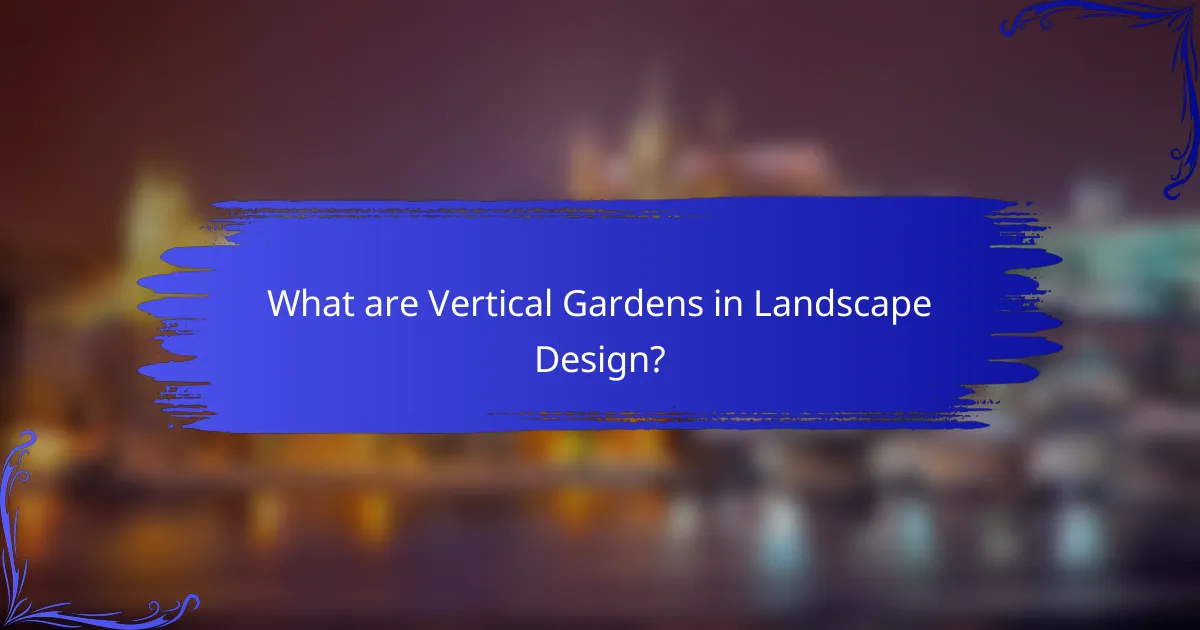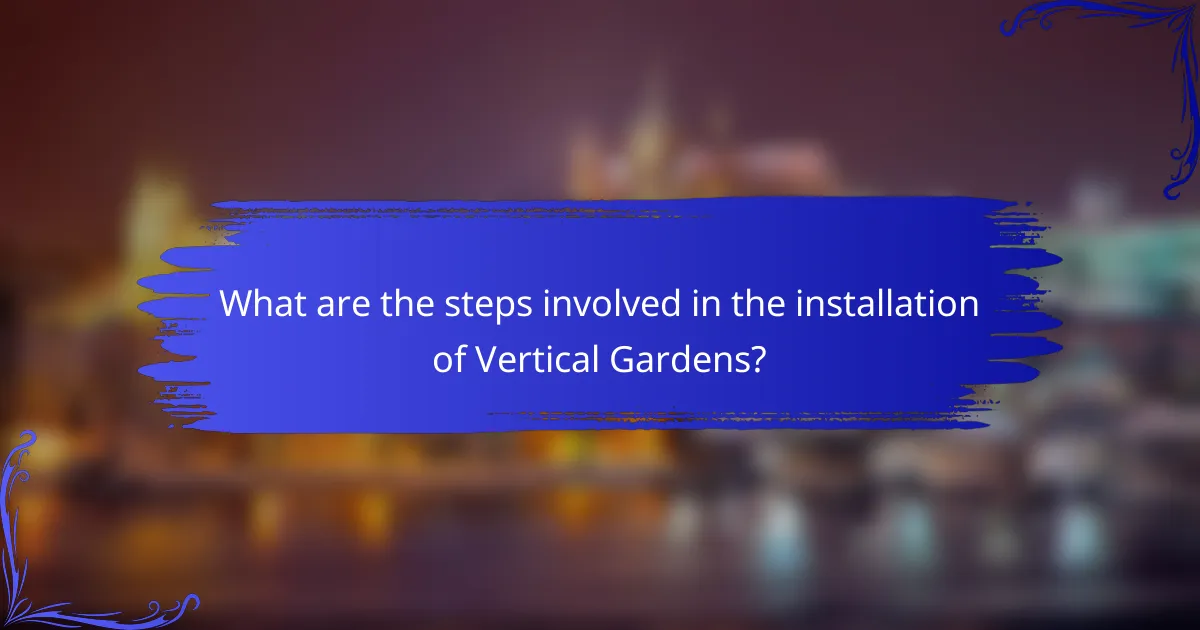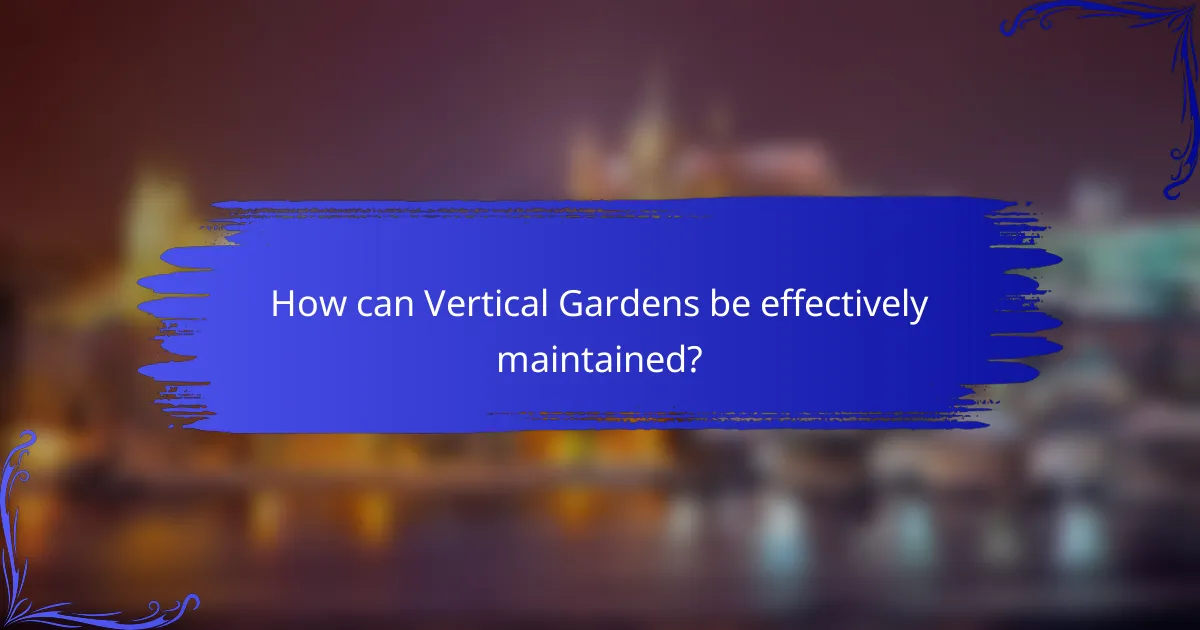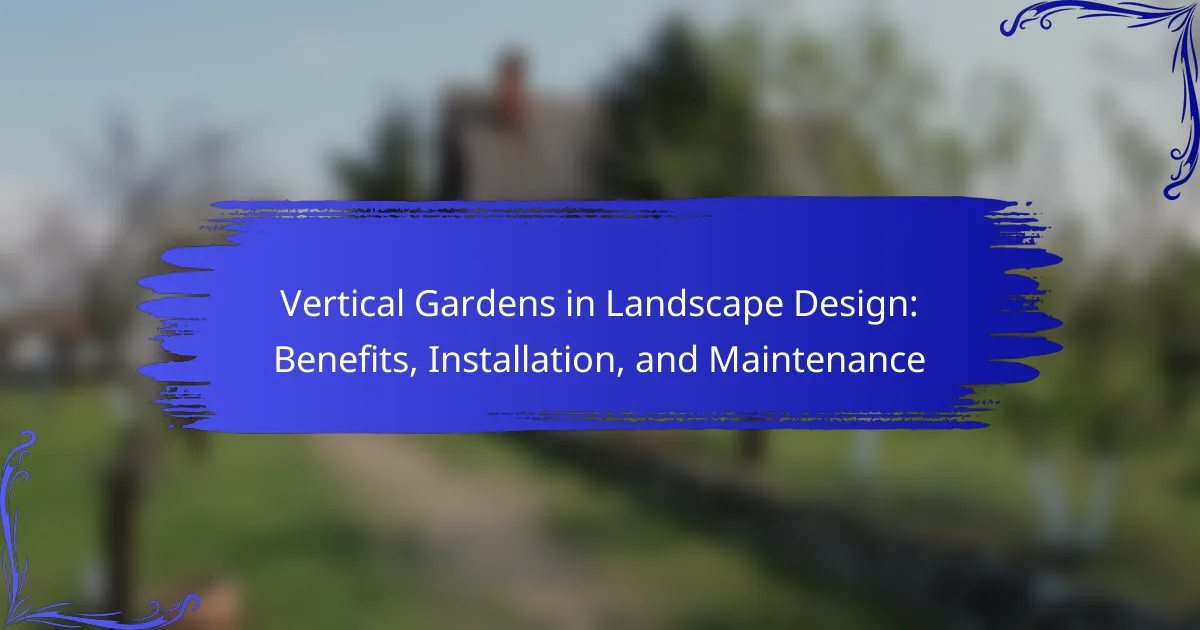Vertical gardens are innovative structures in landscape design that support the growth of various plants, including flowers, herbs, and vegetables, on vertical surfaces. They offer numerous benefits such as space-saving, improved air quality, insulation, and noise reduction, particularly in urban settings. The article outlines the installation process, which includes planning, selecting appropriate plants, preparing the structure, installing an irrigation system, and planting. Maintenance practices are also discussed, emphasizing the importance of regular watering, pruning, pest monitoring, and fertilization to ensure plant health and vitality. Overall, vertical gardens enhance aesthetic appeal and promote biodiversity in diverse environments.

What are Vertical Gardens in Landscape Design?
Vertical gardens in landscape design are vertical structures that support plant growth. They utilize walls or other vertical surfaces to create a garden space. These gardens can be composed of various plants, including flowers, herbs, and vegetables. Vertical gardens save space and can improve air quality. They also provide insulation and reduce noise in urban areas. Studies show that vertical gardens can lower temperatures in surrounding environments. This design approach enhances aesthetic appeal and promotes biodiversity.
How do Vertical Gardens enhance urban spaces?
Vertical gardens enhance urban spaces by improving air quality and providing insulation. They absorb carbon dioxide and release oxygen, contributing to cleaner air. These gardens also reduce urban heat, lowering energy costs for buildings. Studies show that vertical gardens can lower surrounding temperatures by up to 10 degrees Fahrenheit. Additionally, they increase biodiversity by providing habitats for various species. The visual appeal of vertical gardens improves aesthetics, making urban areas more attractive. They can also contribute to mental well-being by offering green spaces in densely populated areas.
What are the essential characteristics of Vertical Gardens?
Vertical gardens are characterized by their ability to grow plants vertically on structures. They utilize wall space to enhance greenery in urban environments. Soil, water, and plant selection are critical components. Vertical gardens improve air quality and provide insulation. They can be designed with various plant species for aesthetic appeal. Irrigation systems are often integrated for efficient water use. Accessibility for maintenance is essential in their design. Vertical gardens can also reduce noise pollution in urban areas.
How do Vertical Gardens differ from traditional gardens?
Vertical gardens differ from traditional gardens primarily in their structure and space utilization. Vertical gardens grow plants on vertical surfaces, such as walls, rather than in horizontal soil beds. This method allows for gardening in limited spaces, making it ideal for urban environments. Traditional gardens require more ground space and a larger footprint. Vertical gardens can enhance air quality and provide insulation for buildings. They often use hydroponic or soil-based systems mounted on walls or frames. Traditional gardens typically rely on direct soil contact for plant growth. Additionally, vertical gardens can create aesthetic appeal by adding greenery to otherwise barren surfaces.
What are the key benefits of incorporating Vertical Gardens?
Vertical gardens offer several key benefits. They improve air quality by filtering pollutants and producing oxygen. Vertical gardens also enhance aesthetic appeal, providing a lush, green environment. They can save space, making them ideal for urban settings. Additionally, they help insulate buildings, reducing energy costs. Vertical gardens can also mitigate urban heat, lowering temperatures in densely populated areas. Furthermore, they promote biodiversity by providing habitats for various species. Studies show that vertical gardens can increase property values by enhancing curb appeal.
How do Vertical Gardens improve air quality?
Vertical gardens improve air quality by filtering pollutants and producing oxygen. They absorb carbon dioxide and release oxygen through photosynthesis. This process enhances the overall air quality in urban environments. Vertical gardens can also trap dust and particulate matter. Studies show that plants can reduce indoor air pollutants by up to 87%. Additionally, they provide insulation, reducing energy consumption and emissions. The presence of greenery promotes a healthier atmosphere for inhabitants.
What aesthetic advantages do Vertical Gardens provide?
Vertical gardens enhance visual appeal through lush greenery and vibrant colors. They create a natural focal point in urban settings. Vertical gardens can transform bland walls into living art. They add depth and texture to landscapes, making spaces feel more dynamic. These gardens promote biodiversity by attracting various species. Research shows that green walls can reduce stress and improve mood. Studies indicate that greenery in urban areas enhances overall well-being. Vertical gardens also contribute to improved air quality, which complements their aesthetic benefits.
How can Vertical Gardens contribute to energy efficiency?
Vertical gardens contribute to energy efficiency by providing natural insulation for buildings. They help regulate indoor temperatures by reducing heat absorption and loss. This can lead to decreased reliance on heating and cooling systems. Studies show that vertical gardens can lower energy consumption by up to 30%. They also improve air quality, which can enhance the efficiency of HVAC systems. By reducing the urban heat island effect, vertical gardens can lower surrounding temperatures. This further decreases energy demands for cooling in nearby structures.

What are the steps involved in the installation of Vertical Gardens?
The steps involved in the installation of vertical gardens include planning, selecting plants, preparing the structure, installing the irrigation system, and planting. First, planning involves choosing the location and design of the vertical garden. This step ensures proper sunlight and accessibility. Next, selecting plants suitable for vertical growth is crucial. Consideration of climate and growth habits will guide this choice.
Preparing the structure involves building or installing a frame or wall system to support the plants. This may include using materials like wood, metal, or pre-made vertical garden systems. After the structure is ready, installing the irrigation system is essential for maintaining plant health. This can involve drip irrigation or a misting system. Finally, planting involves placing the selected plants into the prepared structure. Proper spacing and arrangement will optimize growth and aesthetic appeal.
What are the different types of Vertical Garden systems available?
The different types of vertical garden systems available include modular systems, living walls, green facades, and hydroponic vertical gardens. Modular systems consist of pre-planted panels that can be easily installed and rearranged. Living walls integrate plants into a wall structure with soil or a soilless medium. Green facades use climbing plants supported by a trellis or wire system. Hydroponic vertical gardens grow plants in nutrient-rich water, eliminating the need for soil. Each system offers unique benefits for space utilization and aesthetic appeal in landscape design.
How does each type of system function?
Vertical garden systems function by utilizing various methods to support plant growth in vertical spaces. Hydroponic systems deliver nutrients through water, allowing plants to thrive without soil. Soil-based systems use a growing medium to anchor plants while providing nutrients. Modular systems consist of pre-planted units that can be easily installed and replaced. Each system typically includes a water delivery mechanism to ensure adequate moisture. Additionally, they often feature a drainage system to prevent water accumulation. Research indicates that vertical gardens can improve air quality and reduce urban heat. These benefits are linked to their ability to absorb carbon dioxide and release oxygen.
What are the pros and cons of various Vertical Garden systems?
Vertical garden systems offer distinct advantages and disadvantages. Pros include space efficiency, as they utilize vertical surfaces for planting. This allows for gardening in small areas, such as balconies or urban settings. Vertical gardens also improve air quality by filtering pollutants. They provide insulation, which can reduce energy costs. Additionally, these systems can enhance aesthetic appeal, creating vibrant green walls.
Cons include high installation costs, which can be a barrier for many homeowners. Maintenance can be labor-intensive, requiring regular watering and pruning. Some systems may have limited plant variety due to structural constraints. There is also a risk of water damage to walls if not properly installed. Lastly, vertical gardens can be susceptible to pests and diseases, necessitating vigilant monitoring.
What factors should be considered during the installation process?
Factors to consider during the installation process of vertical gardens include structural support, plant selection, and irrigation systems. Structural support ensures the wall can bear the weight of the garden. Proper plant selection is crucial for the garden’s health and aesthetics. The irrigation system must provide adequate water to all plants. Additionally, sunlight exposure should be assessed for optimal plant growth. Soil type and drainage are also important to prevent waterlogging. Lastly, maintenance access should be planned to facilitate ongoing care. These considerations help ensure a successful vertical garden installation.
How do climate and location affect Vertical Garden installation?
Climate and location significantly influence vertical garden installation. Different climates affect plant selection and growth rates. For instance, arid regions require drought-resistant plants. Conversely, humid areas can support a wider variety of vegetation.
Location determines sunlight exposure and wind patterns. South-facing walls receive more sunlight, benefiting sun-loving plants. In contrast, shaded areas may necessitate shade-tolerant species. Urban environments can create heat islands, impacting temperature and moisture levels.
Local weather patterns also dictate irrigation needs and maintenance schedules. Regions with heavy rainfall may require efficient drainage systems. Understanding these factors ensures successful vertical garden installations tailored to specific environments.
What materials are necessary for a successful installation?
Essential materials for a successful vertical garden installation include a sturdy frame, planting containers, and a growing medium. The frame provides structural support for the garden. It can be made of wood, metal, or plastic. Planting containers hold the soil and plants. They can be pots, pockets, or panels designed for vertical use. A suitable growing medium is crucial for plant health. This typically consists of soil, compost, and moisture-retaining materials. Additionally, a watering system may be necessary for efficient irrigation. Proper drainage materials are also important to prevent waterlogging. These components collectively ensure the vertical garden thrives in its environment.

How can Vertical Gardens be effectively maintained?
Vertical gardens can be effectively maintained through regular watering, pruning, and monitoring for pests. Consistent watering is crucial, as vertical gardens can dry out quickly due to their exposure. It is recommended to check moisture levels daily, especially in hot weather. Pruning is essential to encourage healthy growth and prevent overcrowding. Regularly remove dead or yellowing leaves to maintain aesthetics and plant health. Additionally, monitoring for pests like aphids or spider mites is vital. Early detection allows for timely intervention, minimizing damage. Fertilizing every few months with a balanced fertilizer supports nutrient needs. Lastly, ensuring proper drainage prevents root rot and promotes plant vitality.
What are the essential maintenance tasks for Vertical Gardens?
Essential maintenance tasks for vertical gardens include regular watering, pruning, and pest control. Watering should be consistent to ensure plant health. Pruning is necessary to maintain shape and encourage growth. Pest control involves monitoring for infestations and applying appropriate treatments. Fertilizing is also important to provide necessary nutrients. Cleaning the garden structure helps prevent mold and algae buildup. Checking the irrigation system ensures proper water distribution. Finally, replacing dead plants maintains the aesthetic appeal of the garden. These tasks are crucial for sustaining a healthy vertical garden.
How often should watering and fertilization occur?
Watering should occur daily to every other day, depending on the climate and plant needs. Fertilization typically happens every 4 to 6 weeks during the growing season. Regular watering ensures plants receive adequate moisture. Consistent fertilization provides essential nutrients for growth. Factors like plant type and environmental conditions can affect these frequencies. For instance, warmer climates may require more frequent watering. Conversely, cooler conditions may reduce watering needs. Following these guidelines promotes healthy vertical gardens.
What pest control measures are recommended for Vertical Gardens?
Recommended pest control measures for vertical gardens include regular monitoring for pests. Inspect plants frequently to catch infestations early. Introduce beneficial insects, such as ladybugs and lacewings, to naturally control pest populations. Use organic pesticides like neem oil or insecticidal soap for targeted treatments. Maintain proper plant spacing to improve air circulation and reduce humidity, which deters pests. Ensure healthy soil with adequate nutrients to promote plant resilience against infestations. Implement companion planting to confuse pests and enhance plant health. Regularly remove dead or decaying plant material to minimize pest habitats. These measures collectively support the health of vertical gardens while effectively managing pest issues.
What common challenges do Vertical Gardens face?
Vertical gardens face several common challenges. These include issues with water management, which can lead to overwatering or underwatering. Plant selection is also critical; not all plants thrive in vertical conditions. Maintenance can be labor-intensive, requiring regular pruning and monitoring. Additionally, structural integrity is a concern, as walls must support the weight of soil and plants. Pest management is another challenge, as vertical gardens can attract pests. Lastly, light exposure varies, affecting plant growth and health. These challenges require careful planning and ongoing attention for successful vertical garden implementation.
How can issues with plant health be identified and addressed?
Issues with plant health can be identified through visual inspection and diagnostic tools. Signs of poor health include yellowing leaves, wilting, and stunted growth. Soil testing can reveal nutrient deficiencies or pH imbalances. Pests and diseases can be identified by examining leaves and stems for spots or unusual growths. Addressing these issues involves adjusting watering practices, fertilizing appropriately, and using pest control methods. Regular monitoring and maintenance are essential for preventing future problems. Research indicates that timely intervention can significantly improve plant vitality and yield.
What solutions exist for structural concerns in Vertical Gardens?
Solutions for structural concerns in vertical gardens include using lightweight materials for planting systems. These materials reduce the load on walls and structures. Installing proper drainage systems prevents water accumulation. This helps avoid structural damage over time. Utilizing support frameworks enhances stability and distributes weight evenly. Regular maintenance checks ensure early detection of structural issues. Consulting with structural engineers provides tailored solutions for specific buildings. These practices collectively address the unique challenges posed by vertical gardens.
What best practices should be followed for successful Vertical Garden management?
Successful vertical garden management requires regular maintenance, appropriate plant selection, and effective irrigation systems. Regular maintenance includes pruning and cleaning to promote healthy growth. Choose plants that thrive in vertical environments, such as ferns and succulents. Implement a drip irrigation system to ensure consistent moisture. Monitor light exposure to prevent plant stress. Use quality soil that retains moisture while providing drainage. Fertilize periodically to supply essential nutrients. Finally, assess plant health regularly to address any issues promptly. These practices enhance the longevity and aesthetic appeal of vertical gardens.
Vertical gardens are innovative structures in landscape design that utilize vertical surfaces to support plant growth, enhancing urban environments. This article explores the benefits of vertical gardens, including improved air quality, energy efficiency, and aesthetic appeal, while also detailing the installation process and maintenance practices required for successful management. Key topics include the types of vertical garden systems, essential materials, and common challenges faced, along with best practices for effective care. The information provided aims to equip readers with a comprehensive understanding of vertical gardens, their advantages, and practical implementation strategies.
